Quantitative Prospectus: Obamacare's Impact on Business Strategies
VerifiedAdded on 2021/12/28
|14
|3154
|26
Project
AI Summary
This quantitative prospectus examines the impact of the Affordable Care Act (Obamacare) on businesses, focusing on the strategies they are adopting to meet the employer mandate. The study investigates the rising costs associated with the law, including premiums and fees, and their influence on staffing decisions and employee benefits. It explores the effects of the mandate on business performance, with research questions addressing the impact of costs, staffing changes, and employee benefit adjustments. The research employs a quantitative design to analyze the relationship between Obamacare and business outcomes, using a pluralistic framework to understand the interplay of socio-political, economic, and public health perspectives. The study aims to provide insights into how businesses are responding to the changing regulatory environment and mitigating the financial and operational challenges posed by the Affordable Care Act, including the "Play or Pay Rule" mandate.
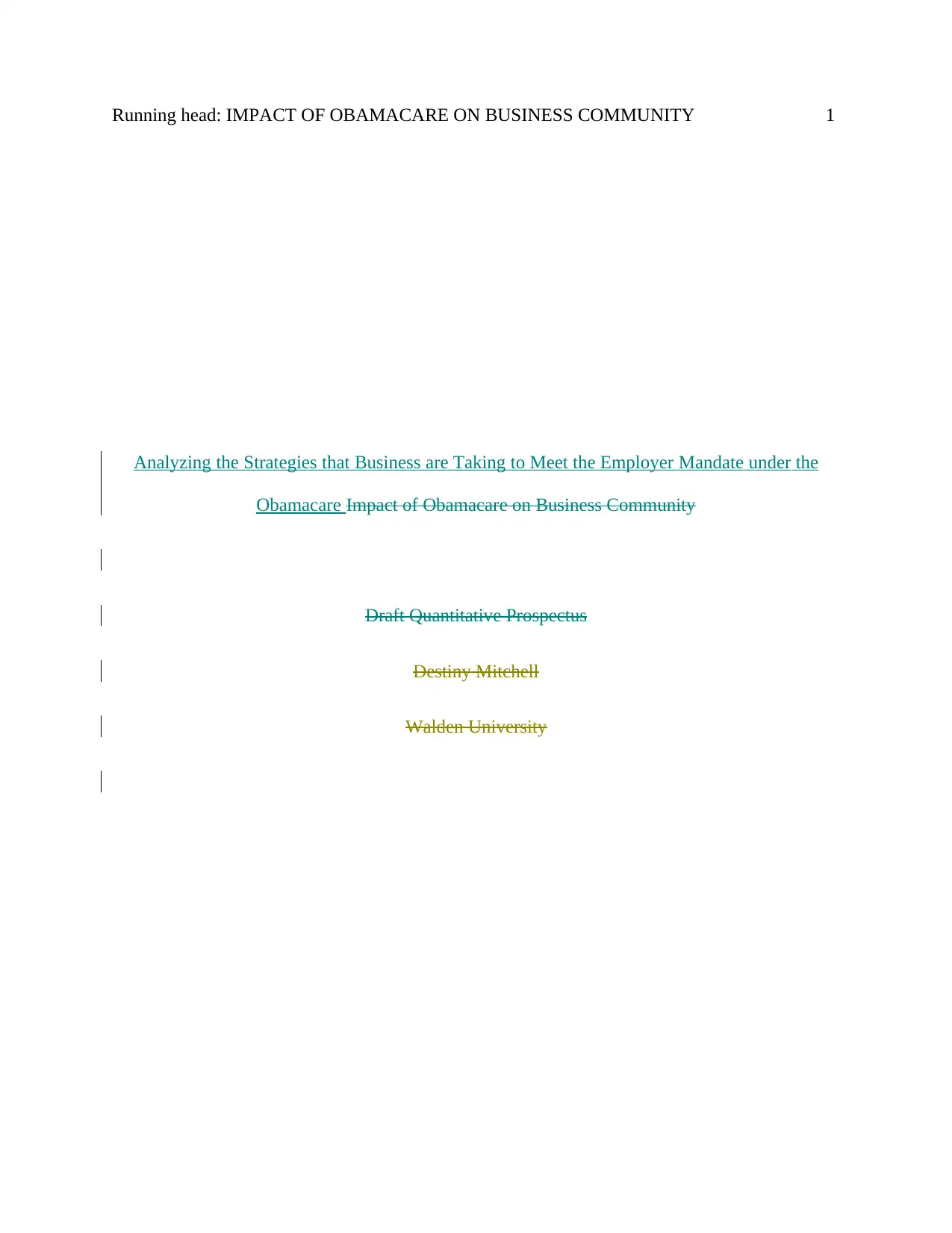
Running head: IMPACT OF OBAMACARE ON BUSINESS COMMUNITY 1
Analyzing the Strategies that Business are Taking to Meet the Employer Mandate under the
Obamacare Impact of Obamacare on Business Community
Draft Quantitative Prospectus
Destiny Mitchell
Walden University
Analyzing the Strategies that Business are Taking to Meet the Employer Mandate under the
Obamacare Impact of Obamacare on Business Community
Draft Quantitative Prospectus
Destiny Mitchell
Walden University
Paraphrase This Document
Need a fresh take? Get an instant paraphrase of this document with our AI Paraphraser
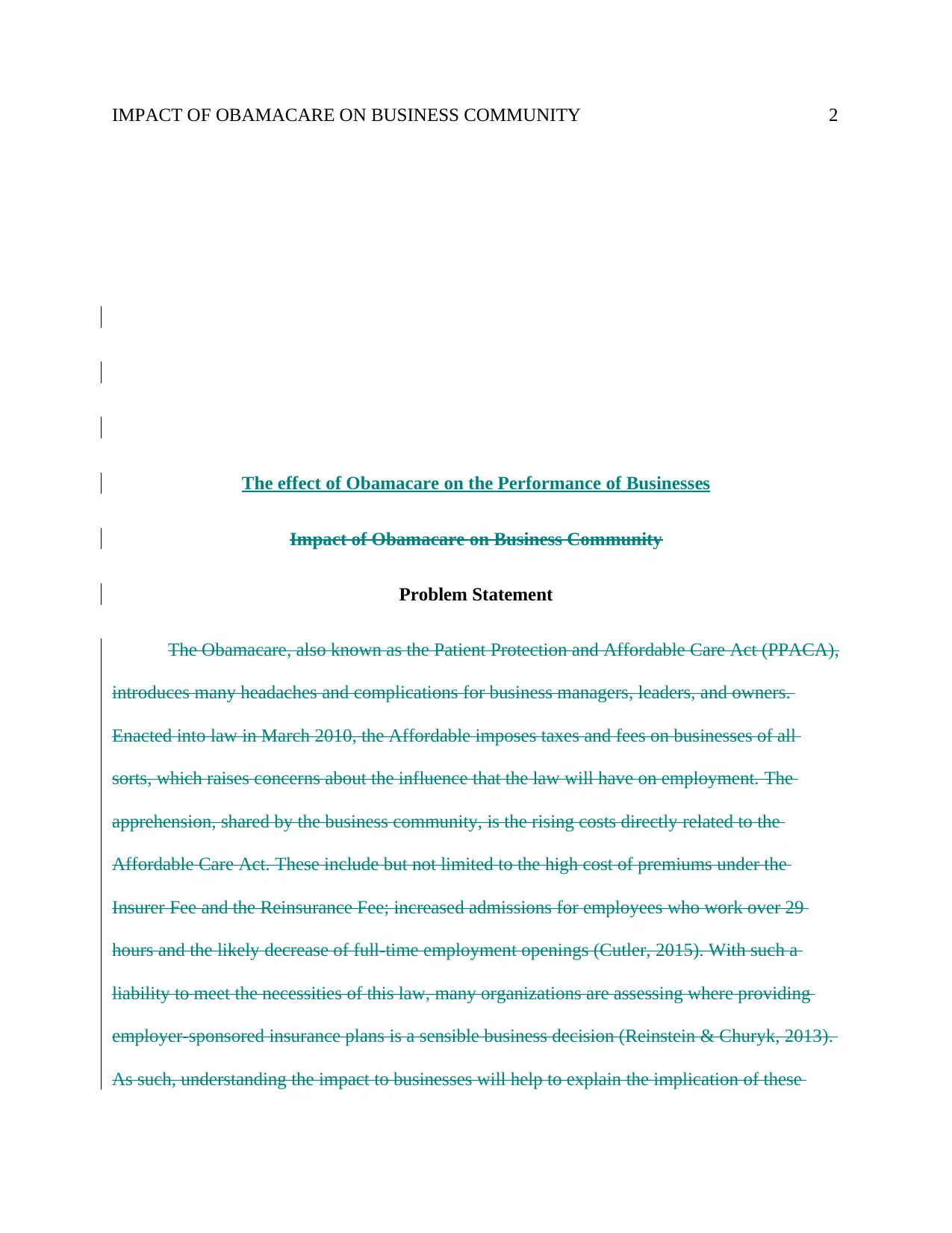
IMPACT OF OBAMACARE ON BUSINESS COMMUNITY 2
The effect of Obamacare on the Performance of Businesses
Impact of Obamacare on Business Community
Problem Statement
The Obamacare, also known as the Patient Protection and Affordable Care Act (PPACA),
introduces many headaches and complications for business managers, leaders, and owners.
Enacted into law in March 2010, the Affordable imposes taxes and fees on businesses of all
sorts, which raises concerns about the influence that the law will have on employment. The
apprehension, shared by the business community, is the rising costs directly related to the
Affordable Care Act. These include but not limited to the high cost of premiums under the
Insurer Fee and the Reinsurance Fee; increased admissions for employees who work over 29
hours and the likely decrease of full-time employment openings (Cutler, 2015). With such a
liability to meet the necessities of this law, many organizations are assessing where providing
employer-sponsored insurance plans is a sensible business decision (Reinstein & Churyk, 2013).
As such, understanding the impact to businesses will help to explain the implication of these
The effect of Obamacare on the Performance of Businesses
Impact of Obamacare on Business Community
Problem Statement
The Obamacare, also known as the Patient Protection and Affordable Care Act (PPACA),
introduces many headaches and complications for business managers, leaders, and owners.
Enacted into law in March 2010, the Affordable imposes taxes and fees on businesses of all
sorts, which raises concerns about the influence that the law will have on employment. The
apprehension, shared by the business community, is the rising costs directly related to the
Affordable Care Act. These include but not limited to the high cost of premiums under the
Insurer Fee and the Reinsurance Fee; increased admissions for employees who work over 29
hours and the likely decrease of full-time employment openings (Cutler, 2015). With such a
liability to meet the necessities of this law, many organizations are assessing where providing
employer-sponsored insurance plans is a sensible business decision (Reinstein & Churyk, 2013).
As such, understanding the impact to businesses will help to explain the implication of these
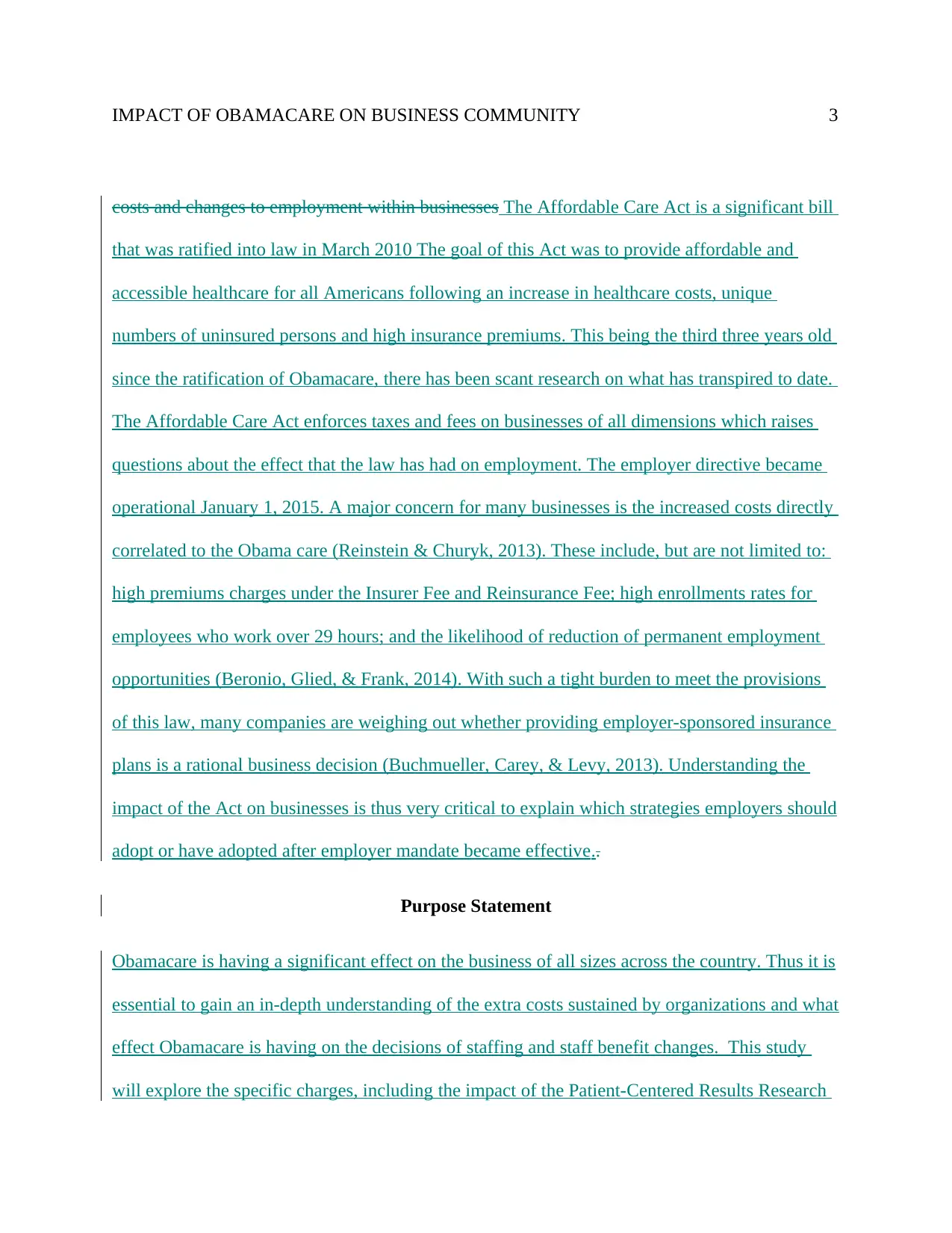
IMPACT OF OBAMACARE ON BUSINESS COMMUNITY 3
costs and changes to employment within businesses The Affordable Care Act is a significant bill
that was ratified into law in March 2010 The goal of this Act was to provide affordable and
accessible healthcare for all Americans following an increase in healthcare costs, unique
numbers of uninsured persons and high insurance premiums. This being the third three years old
since the ratification of Obamacare, there has been scant research on what has transpired to date.
The Affordable Care Act enforces taxes and fees on businesses of all dimensions which raises
questions about the effect that the law has had on employment. The employer directive became
operational January 1, 2015. A major concern for many businesses is the increased costs directly
correlated to the Obama care (Reinstein & Churyk, 2013). These include, but are not limited to:
high premiums charges under the Insurer Fee and Reinsurance Fee; high enrollments rates for
employees who work over 29 hours; and the likelihood of reduction of permanent employment
opportunities (Beronio, Glied, & Frank, 2014). With such a tight burden to meet the provisions
of this law, many companies are weighing out whether providing employer-sponsored insurance
plans is a rational business decision (Buchmueller, Carey, & Levy, 2013). Understanding the
impact of the Act on businesses is thus very critical to explain which strategies employers should
adopt or have adopted after employer mandate became effective..
Purpose Statement
Obamacare is having a significant effect on the business of all sizes across the country. Thus it is
essential to gain an in-depth understanding of the extra costs sustained by organizations and what
effect Obamacare is having on the decisions of staffing and staff benefit changes. This study
will explore the specific charges, including the impact of the Patient-Centered Results Research
costs and changes to employment within businesses The Affordable Care Act is a significant bill
that was ratified into law in March 2010 The goal of this Act was to provide affordable and
accessible healthcare for all Americans following an increase in healthcare costs, unique
numbers of uninsured persons and high insurance premiums. This being the third three years old
since the ratification of Obamacare, there has been scant research on what has transpired to date.
The Affordable Care Act enforces taxes and fees on businesses of all dimensions which raises
questions about the effect that the law has had on employment. The employer directive became
operational January 1, 2015. A major concern for many businesses is the increased costs directly
correlated to the Obama care (Reinstein & Churyk, 2013). These include, but are not limited to:
high premiums charges under the Insurer Fee and Reinsurance Fee; high enrollments rates for
employees who work over 29 hours; and the likelihood of reduction of permanent employment
opportunities (Beronio, Glied, & Frank, 2014). With such a tight burden to meet the provisions
of this law, many companies are weighing out whether providing employer-sponsored insurance
plans is a rational business decision (Buchmueller, Carey, & Levy, 2013). Understanding the
impact of the Act on businesses is thus very critical to explain which strategies employers should
adopt or have adopted after employer mandate became effective..
Purpose Statement
Obamacare is having a significant effect on the business of all sizes across the country. Thus it is
essential to gain an in-depth understanding of the extra costs sustained by organizations and what
effect Obamacare is having on the decisions of staffing and staff benefit changes. This study
will explore the specific charges, including the impact of the Patient-Centered Results Research
⊘ This is a preview!⊘
Do you want full access?
Subscribe today to unlock all pages.

Trusted by 1+ million students worldwide
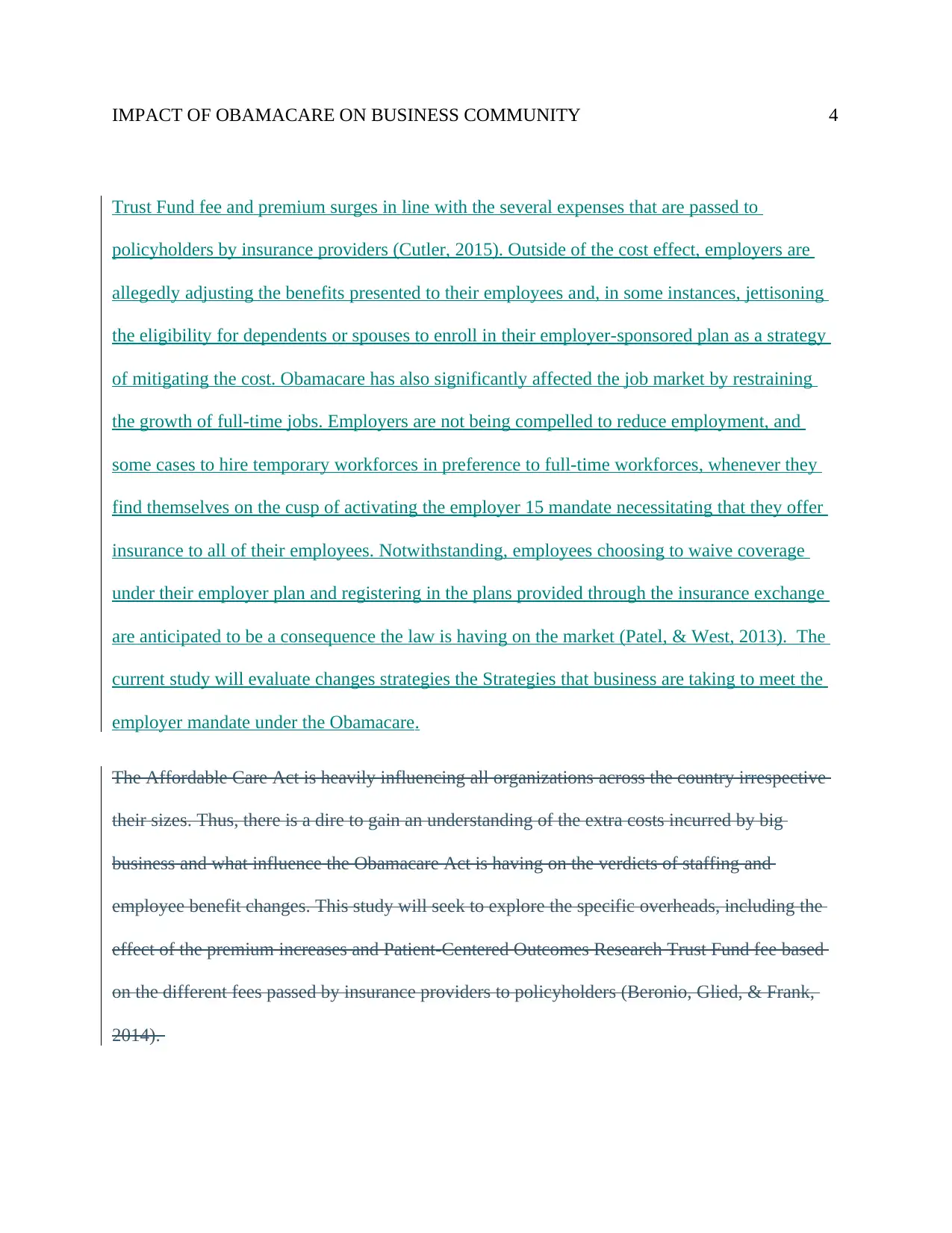
IMPACT OF OBAMACARE ON BUSINESS COMMUNITY 4
Trust Fund fee and premium surges in line with the several expenses that are passed to
policyholders by insurance providers (Cutler, 2015). Outside of the cost effect, employers are
allegedly adjusting the benefits presented to their employees and, in some instances, jettisoning
the eligibility for dependents or spouses to enroll in their employer-sponsored plan as a strategy
of mitigating the cost. Obamacare has also significantly affected the job market by restraining
the growth of full-time jobs. Employers are not being compelled to reduce employment, and
some cases to hire temporary workforces in preference to full-time workforces, whenever they
find themselves on the cusp of activating the employer 15 mandate necessitating that they offer
insurance to all of their employees. Notwithstanding, employees choosing to waive coverage
under their employer plan and registering in the plans provided through the insurance exchange
are anticipated to be a consequence the law is having on the market (Patel, & West, 2013). The
current study will evaluate changes strategies the Strategies that business are taking to meet the
employer mandate under the Obamacare.
The Affordable Care Act is heavily influencing all organizations across the country irrespective
their sizes. Thus, there is a dire to gain an understanding of the extra costs incurred by big
business and what influence the Obamacare Act is having on the verdicts of staffing and
employee benefit changes. This study will seek to explore the specific overheads, including the
effect of the premium increases and Patient-Centered Outcomes Research Trust Fund fee based
on the different fees passed by insurance providers to policyholders (Beronio, Glied, & Frank,
2014).
Trust Fund fee and premium surges in line with the several expenses that are passed to
policyholders by insurance providers (Cutler, 2015). Outside of the cost effect, employers are
allegedly adjusting the benefits presented to their employees and, in some instances, jettisoning
the eligibility for dependents or spouses to enroll in their employer-sponsored plan as a strategy
of mitigating the cost. Obamacare has also significantly affected the job market by restraining
the growth of full-time jobs. Employers are not being compelled to reduce employment, and
some cases to hire temporary workforces in preference to full-time workforces, whenever they
find themselves on the cusp of activating the employer 15 mandate necessitating that they offer
insurance to all of their employees. Notwithstanding, employees choosing to waive coverage
under their employer plan and registering in the plans provided through the insurance exchange
are anticipated to be a consequence the law is having on the market (Patel, & West, 2013). The
current study will evaluate changes strategies the Strategies that business are taking to meet the
employer mandate under the Obamacare.
The Affordable Care Act is heavily influencing all organizations across the country irrespective
their sizes. Thus, there is a dire to gain an understanding of the extra costs incurred by big
business and what influence the Obamacare Act is having on the verdicts of staffing and
employee benefit changes. This study will seek to explore the specific overheads, including the
effect of the premium increases and Patient-Centered Outcomes Research Trust Fund fee based
on the different fees passed by insurance providers to policyholders (Beronio, Glied, & Frank,
2014).
Paraphrase This Document
Need a fresh take? Get an instant paraphrase of this document with our AI Paraphraser
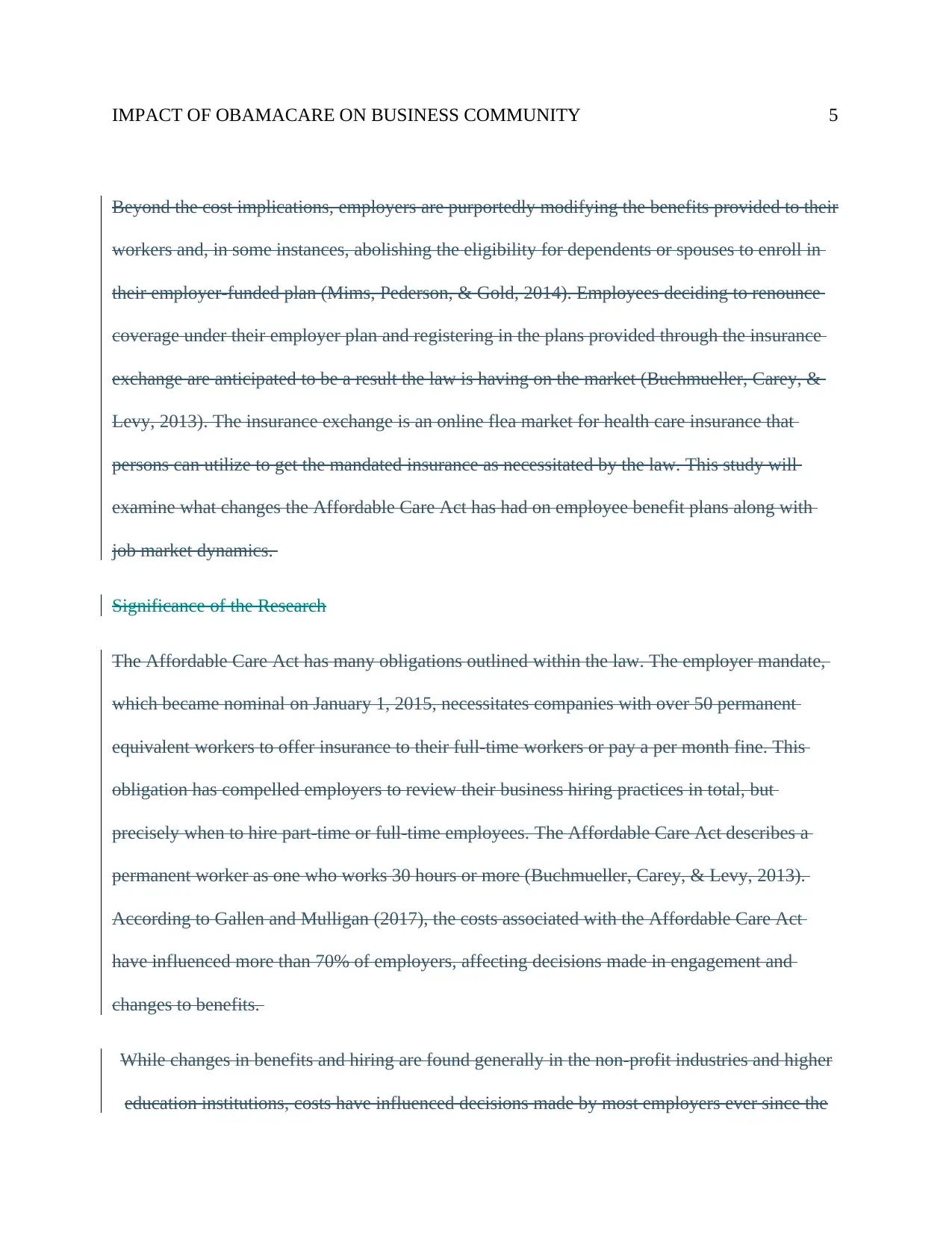
IMPACT OF OBAMACARE ON BUSINESS COMMUNITY 5
Beyond the cost implications, employers are purportedly modifying the benefits provided to their
workers and, in some instances, abolishing the eligibility for dependents or spouses to enroll in
their employer-funded plan (Mims, Pederson, & Gold, 2014). Employees deciding to renounce
coverage under their employer plan and registering in the plans provided through the insurance
exchange are anticipated to be a result the law is having on the market (Buchmueller, Carey, &
Levy, 2013). The insurance exchange is an online flea market for health care insurance that
persons can utilize to get the mandated insurance as necessitated by the law. This study will
examine what changes the Affordable Care Act has had on employee benefit plans along with
job market dynamics.
Significance of the Research
The Affordable Care Act has many obligations outlined within the law. The employer mandate,
which became nominal on January 1, 2015, necessitates companies with over 50 permanent
equivalent workers to offer insurance to their full-time workers or pay a per month fine. This
obligation has compelled employers to review their business hiring practices in total, but
precisely when to hire part-time or full-time employees. The Affordable Care Act describes a
permanent worker as one who works 30 hours or more (Buchmueller, Carey, & Levy, 2013).
According to Gallen and Mulligan (2017), the costs associated with the Affordable Care Act
have influenced more than 70% of employers, affecting decisions made in engagement and
changes to benefits.
While changes in benefits and hiring are found generally in the non-profit industries and higher
education institutions, costs have influenced decisions made by most employers ever since the
Beyond the cost implications, employers are purportedly modifying the benefits provided to their
workers and, in some instances, abolishing the eligibility for dependents or spouses to enroll in
their employer-funded plan (Mims, Pederson, & Gold, 2014). Employees deciding to renounce
coverage under their employer plan and registering in the plans provided through the insurance
exchange are anticipated to be a result the law is having on the market (Buchmueller, Carey, &
Levy, 2013). The insurance exchange is an online flea market for health care insurance that
persons can utilize to get the mandated insurance as necessitated by the law. This study will
examine what changes the Affordable Care Act has had on employee benefit plans along with
job market dynamics.
Significance of the Research
The Affordable Care Act has many obligations outlined within the law. The employer mandate,
which became nominal on January 1, 2015, necessitates companies with over 50 permanent
equivalent workers to offer insurance to their full-time workers or pay a per month fine. This
obligation has compelled employers to review their business hiring practices in total, but
precisely when to hire part-time or full-time employees. The Affordable Care Act describes a
permanent worker as one who works 30 hours or more (Buchmueller, Carey, & Levy, 2013).
According to Gallen and Mulligan (2017), the costs associated with the Affordable Care Act
have influenced more than 70% of employers, affecting decisions made in engagement and
changes to benefits.
While changes in benefits and hiring are found generally in the non-profit industries and higher
education institutions, costs have influenced decisions made by most employers ever since the
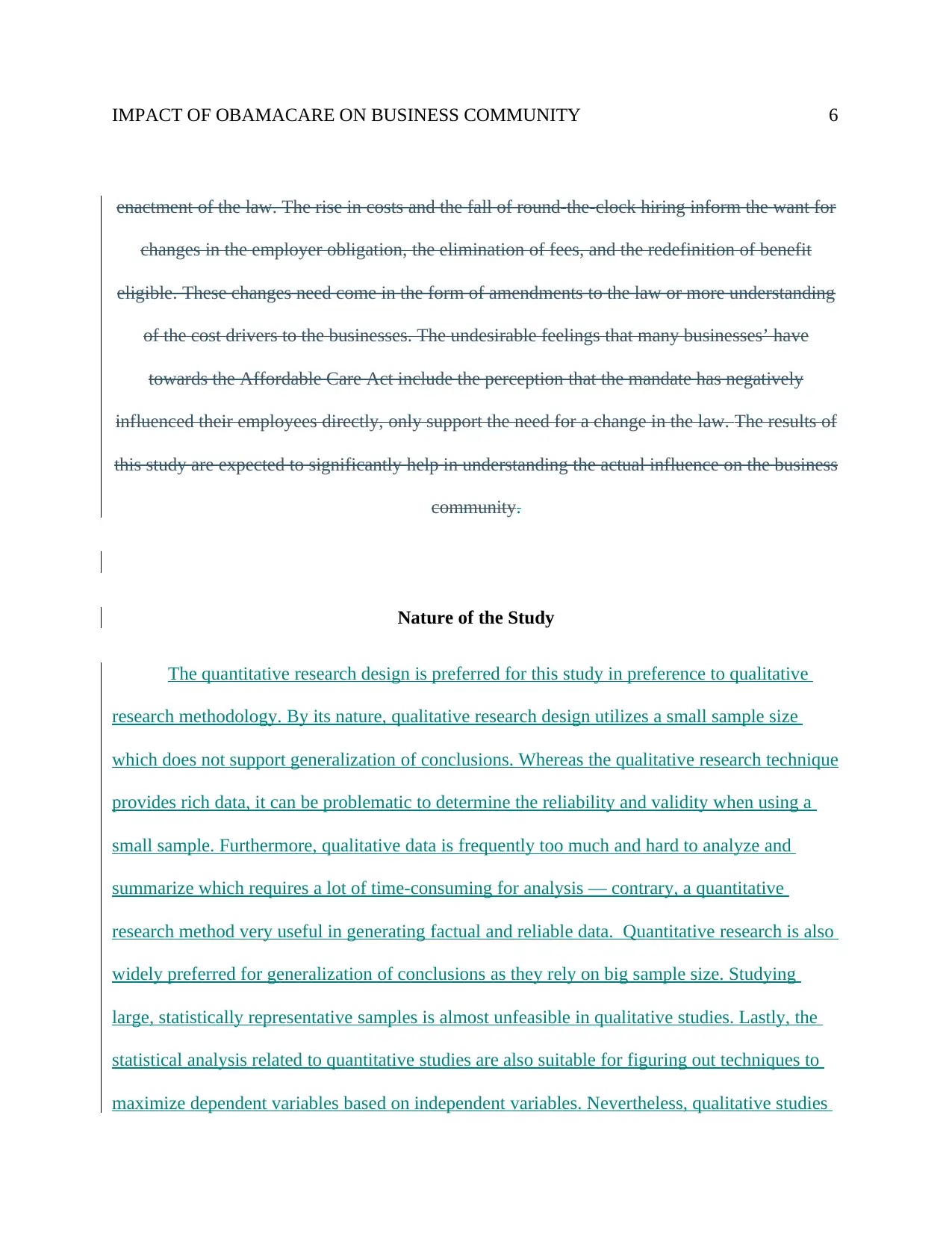
IMPACT OF OBAMACARE ON BUSINESS COMMUNITY 6
enactment of the law. The rise in costs and the fall of round-the-clock hiring inform the want for
changes in the employer obligation, the elimination of fees, and the redefinition of benefit
eligible. These changes need come in the form of amendments to the law or more understanding
of the cost drivers to the businesses. The undesirable feelings that many businesses’ have
towards the Affordable Care Act include the perception that the mandate has negatively
influenced their employees directly, only support the need for a change in the law. The results of
this study are expected to significantly help in understanding the actual influence on the business
community.
Nature of the Study
The quantitative research design is preferred for this study in preference to qualitative
research methodology. By its nature, qualitative research design utilizes a small sample size
which does not support generalization of conclusions. Whereas the qualitative research technique
provides rich data, it can be problematic to determine the reliability and validity when using a
small sample. Furthermore, qualitative data is frequently too much and hard to analyze and
summarize which requires a lot of time-consuming for analysis — contrary, a quantitative
research method very useful in generating factual and reliable data. Quantitative research is also
widely preferred for generalization of conclusions as they rely on big sample size. Studying
large, statistically representative samples is almost unfeasible in qualitative studies. Lastly, the
statistical analysis related to quantitative studies are also suitable for figuring out techniques to
maximize dependent variables based on independent variables. Nevertheless, qualitative studies
enactment of the law. The rise in costs and the fall of round-the-clock hiring inform the want for
changes in the employer obligation, the elimination of fees, and the redefinition of benefit
eligible. These changes need come in the form of amendments to the law or more understanding
of the cost drivers to the businesses. The undesirable feelings that many businesses’ have
towards the Affordable Care Act include the perception that the mandate has negatively
influenced their employees directly, only support the need for a change in the law. The results of
this study are expected to significantly help in understanding the actual influence on the business
community.
Nature of the Study
The quantitative research design is preferred for this study in preference to qualitative
research methodology. By its nature, qualitative research design utilizes a small sample size
which does not support generalization of conclusions. Whereas the qualitative research technique
provides rich data, it can be problematic to determine the reliability and validity when using a
small sample. Furthermore, qualitative data is frequently too much and hard to analyze and
summarize which requires a lot of time-consuming for analysis — contrary, a quantitative
research method very useful in generating factual and reliable data. Quantitative research is also
widely preferred for generalization of conclusions as they rely on big sample size. Studying
large, statistically representative samples is almost unfeasible in qualitative studies. Lastly, the
statistical analysis related to quantitative studies are also suitable for figuring out techniques to
maximize dependent variables based on independent variables. Nevertheless, qualitative studies
⊘ This is a preview!⊘
Do you want full access?
Subscribe today to unlock all pages.

Trusted by 1+ million students worldwide
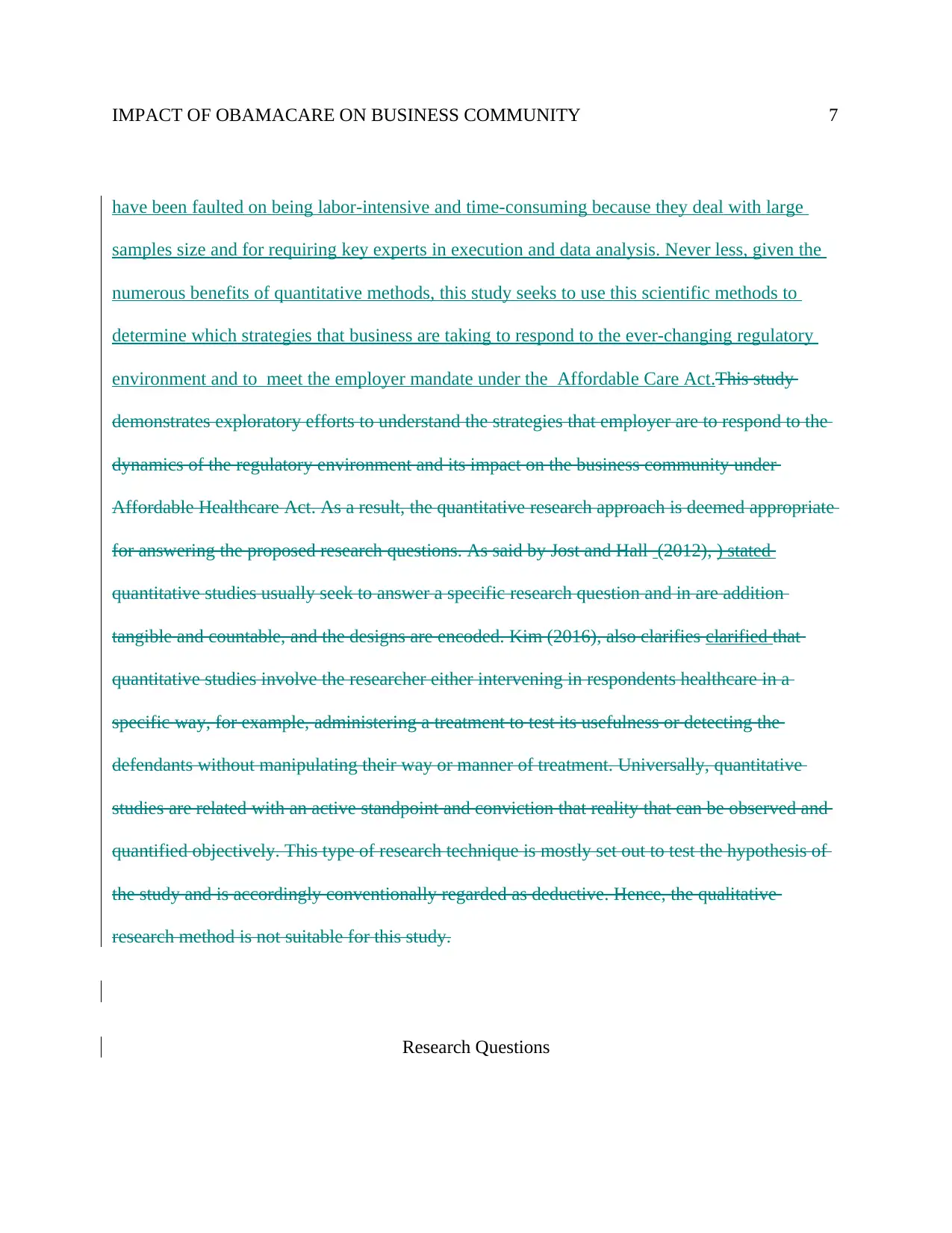
IMPACT OF OBAMACARE ON BUSINESS COMMUNITY 7
have been faulted on being labor-intensive and time-consuming because they deal with large
samples size and for requiring key experts in execution and data analysis. Never less, given the
numerous benefits of quantitative methods, this study seeks to use this scientific methods to
determine which strategies that business are taking to respond to the ever-changing regulatory
environment and to meet the employer mandate under the Affordable Care Act.This study
demonstrates exploratory efforts to understand the strategies that employer are to respond to the
dynamics of the regulatory environment and its impact on the business community under
Affordable Healthcare Act. As a result, the quantitative research approach is deemed appropriate
for answering the proposed research questions. As said by Jost and Hall (2012), ) stated
quantitative studies usually seek to answer a specific research question and in are addition
tangible and countable, and the designs are encoded. Kim (2016), also clarifies clarified that
quantitative studies involve the researcher either intervening in respondents healthcare in a
specific way, for example, administering a treatment to test its usefulness or detecting the
defendants without manipulating their way or manner of treatment. Universally, quantitative
studies are related with an active standpoint and conviction that reality that can be observed and
quantified objectively. This type of research technique is mostly set out to test the hypothesis of
the study and is accordingly conventionally regarded as deductive. Hence, the qualitative
research method is not suitable for this study.
Research Questions
have been faulted on being labor-intensive and time-consuming because they deal with large
samples size and for requiring key experts in execution and data analysis. Never less, given the
numerous benefits of quantitative methods, this study seeks to use this scientific methods to
determine which strategies that business are taking to respond to the ever-changing regulatory
environment and to meet the employer mandate under the Affordable Care Act.This study
demonstrates exploratory efforts to understand the strategies that employer are to respond to the
dynamics of the regulatory environment and its impact on the business community under
Affordable Healthcare Act. As a result, the quantitative research approach is deemed appropriate
for answering the proposed research questions. As said by Jost and Hall (2012), ) stated
quantitative studies usually seek to answer a specific research question and in are addition
tangible and countable, and the designs are encoded. Kim (2016), also clarifies clarified that
quantitative studies involve the researcher either intervening in respondents healthcare in a
specific way, for example, administering a treatment to test its usefulness or detecting the
defendants without manipulating their way or manner of treatment. Universally, quantitative
studies are related with an active standpoint and conviction that reality that can be observed and
quantified objectively. This type of research technique is mostly set out to test the hypothesis of
the study and is accordingly conventionally regarded as deductive. Hence, the qualitative
research method is not suitable for this study.
Research Questions
Paraphrase This Document
Need a fresh take? Get an instant paraphrase of this document with our AI Paraphraser
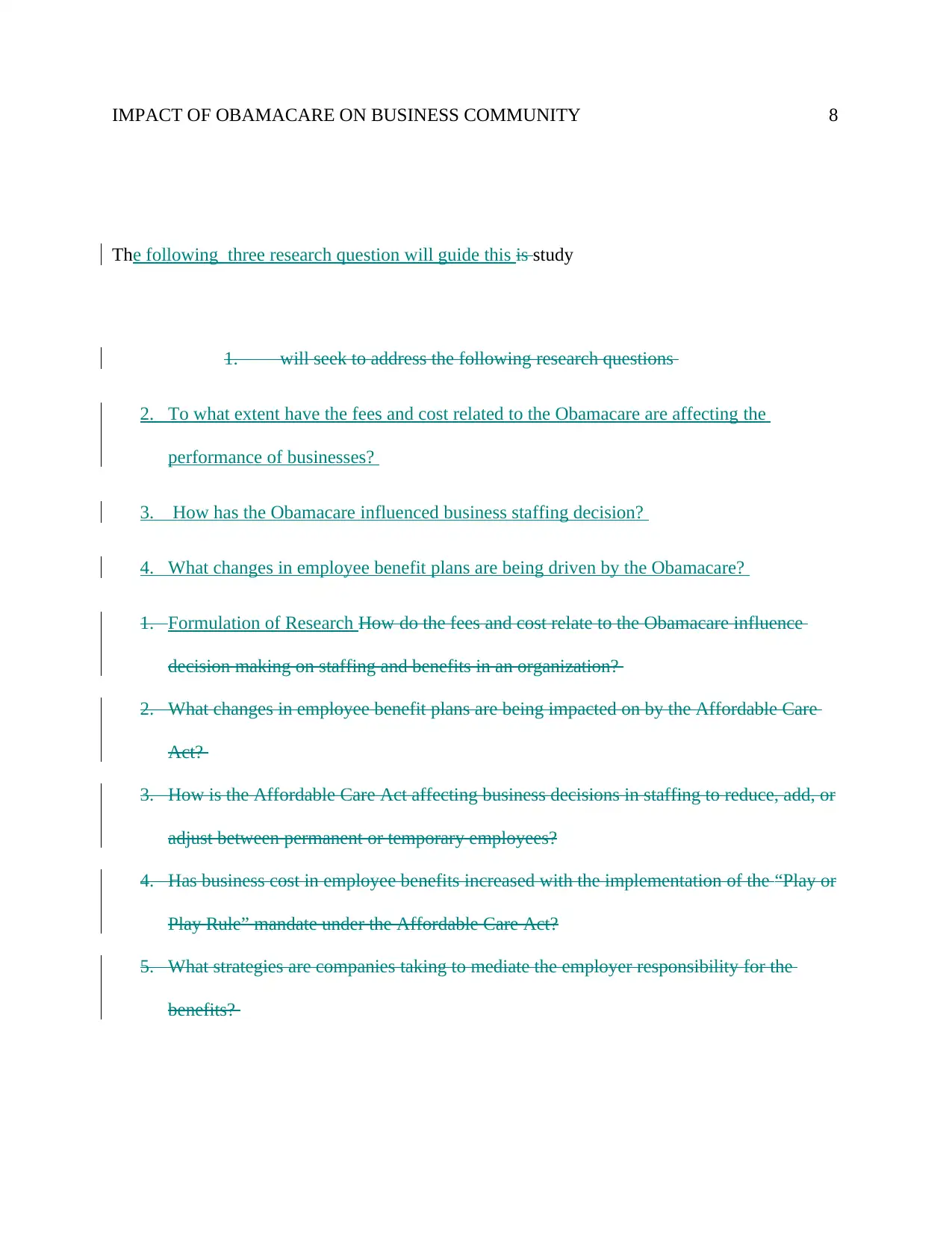
IMPACT OF OBAMACARE ON BUSINESS COMMUNITY 8
The following three research question will guide this is study
1. will seek to address the following research questions
2. To what extent have the fees and cost related to the Obamacare are affecting the
performance of businesses?
3. How has the Obamacare influenced business staffing decision?
4. What changes in employee benefit plans are being driven by the Obamacare?
1. Formulation of Research How do the fees and cost relate to the Obamacare influence
decision making on staffing and benefits in an organization?
2. What changes in employee benefit plans are being impacted on by the Affordable Care
Act?
3. How is the Affordable Care Act affecting business decisions in staffing to reduce, add, or
adjust between permanent or temporary employees?
4. Has business cost in employee benefits increased with the implementation of the “Play or
Play Rule” mandate under the Affordable Care Act?
5. What strategies are companies taking to mediate the employer responsibility for the
benefits?
The following three research question will guide this is study
1. will seek to address the following research questions
2. To what extent have the fees and cost related to the Obamacare are affecting the
performance of businesses?
3. How has the Obamacare influenced business staffing decision?
4. What changes in employee benefit plans are being driven by the Obamacare?
1. Formulation of Research How do the fees and cost relate to the Obamacare influence
decision making on staffing and benefits in an organization?
2. What changes in employee benefit plans are being impacted on by the Affordable Care
Act?
3. How is the Affordable Care Act affecting business decisions in staffing to reduce, add, or
adjust between permanent or temporary employees?
4. Has business cost in employee benefits increased with the implementation of the “Play or
Play Rule” mandate under the Affordable Care Act?
5. What strategies are companies taking to mediate the employer responsibility for the
benefits?
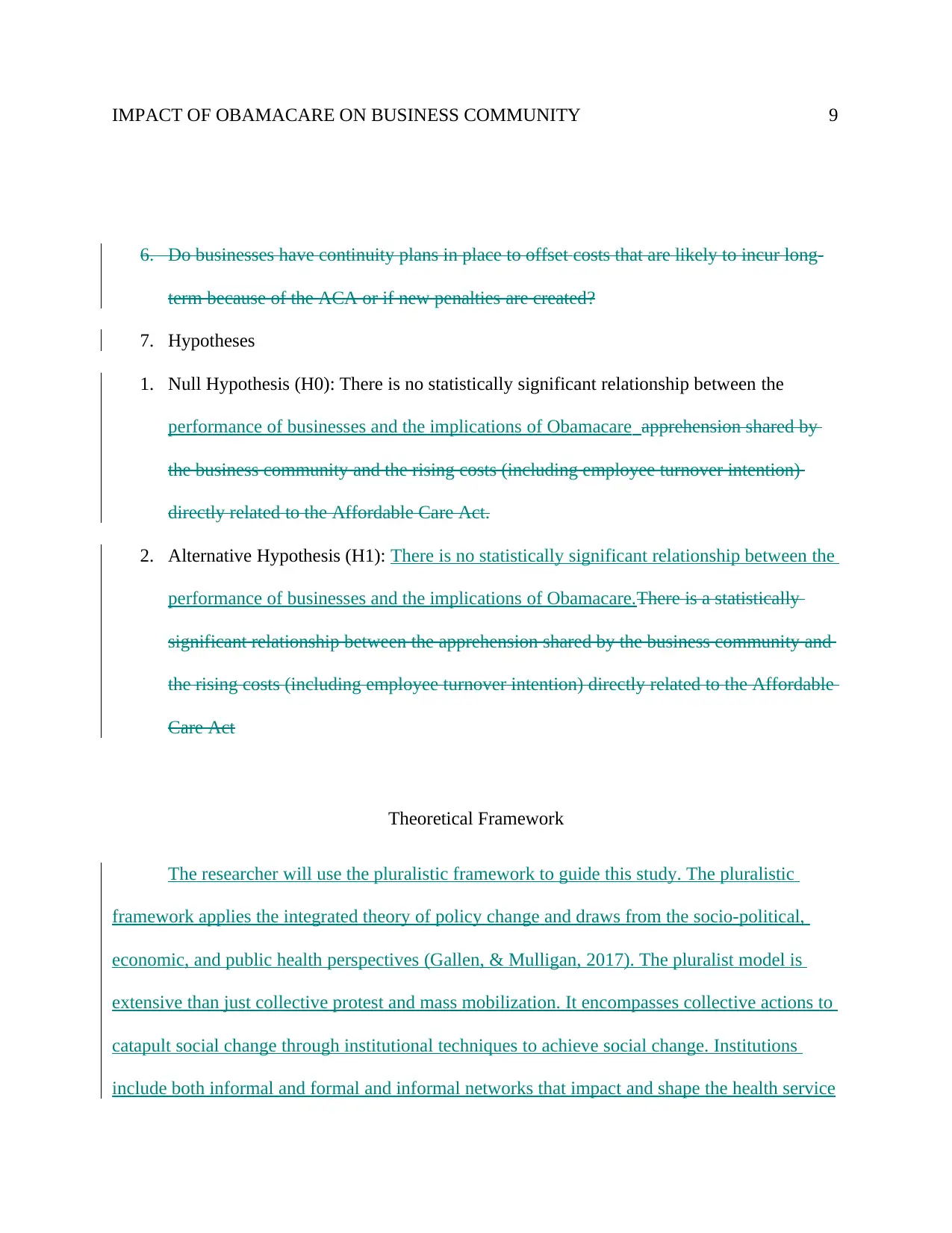
IMPACT OF OBAMACARE ON BUSINESS COMMUNITY 9
6. Do businesses have continuity plans in place to offset costs that are likely to incur long-
term because of the ACA or if new penalties are created?
7. Hypotheses
1. Null Hypothesis (H0): There is no statistically significant relationship between the
performance of businesses and the implications of Obamacare apprehension shared by
the business community and the rising costs (including employee turnover intention)
directly related to the Affordable Care Act.
2. Alternative Hypothesis (H1): There is no statistically significant relationship between the
performance of businesses and the implications of Obamacare.There is a statistically
significant relationship between the apprehension shared by the business community and
the rising costs (including employee turnover intention) directly related to the Affordable
Care Act
Theoretical Framework
The researcher will use the pluralistic framework to guide this study. The pluralistic
framework applies the integrated theory of policy change and draws from the socio-political,
economic, and public health perspectives (Gallen, & Mulligan, 2017). The pluralist model is
extensive than just collective protest and mass mobilization. It encompasses collective actions to
catapult social change through institutional techniques to achieve social change. Institutions
include both informal and formal and informal networks that impact and shape the health service
6. Do businesses have continuity plans in place to offset costs that are likely to incur long-
term because of the ACA or if new penalties are created?
7. Hypotheses
1. Null Hypothesis (H0): There is no statistically significant relationship between the
performance of businesses and the implications of Obamacare apprehension shared by
the business community and the rising costs (including employee turnover intention)
directly related to the Affordable Care Act.
2. Alternative Hypothesis (H1): There is no statistically significant relationship between the
performance of businesses and the implications of Obamacare.There is a statistically
significant relationship between the apprehension shared by the business community and
the rising costs (including employee turnover intention) directly related to the Affordable
Care Act
Theoretical Framework
The researcher will use the pluralistic framework to guide this study. The pluralistic
framework applies the integrated theory of policy change and draws from the socio-political,
economic, and public health perspectives (Gallen, & Mulligan, 2017). The pluralist model is
extensive than just collective protest and mass mobilization. It encompasses collective actions to
catapult social change through institutional techniques to achieve social change. Institutions
include both informal and formal and informal networks that impact and shape the health service
⊘ This is a preview!⊘
Do you want full access?
Subscribe today to unlock all pages.

Trusted by 1+ million students worldwide
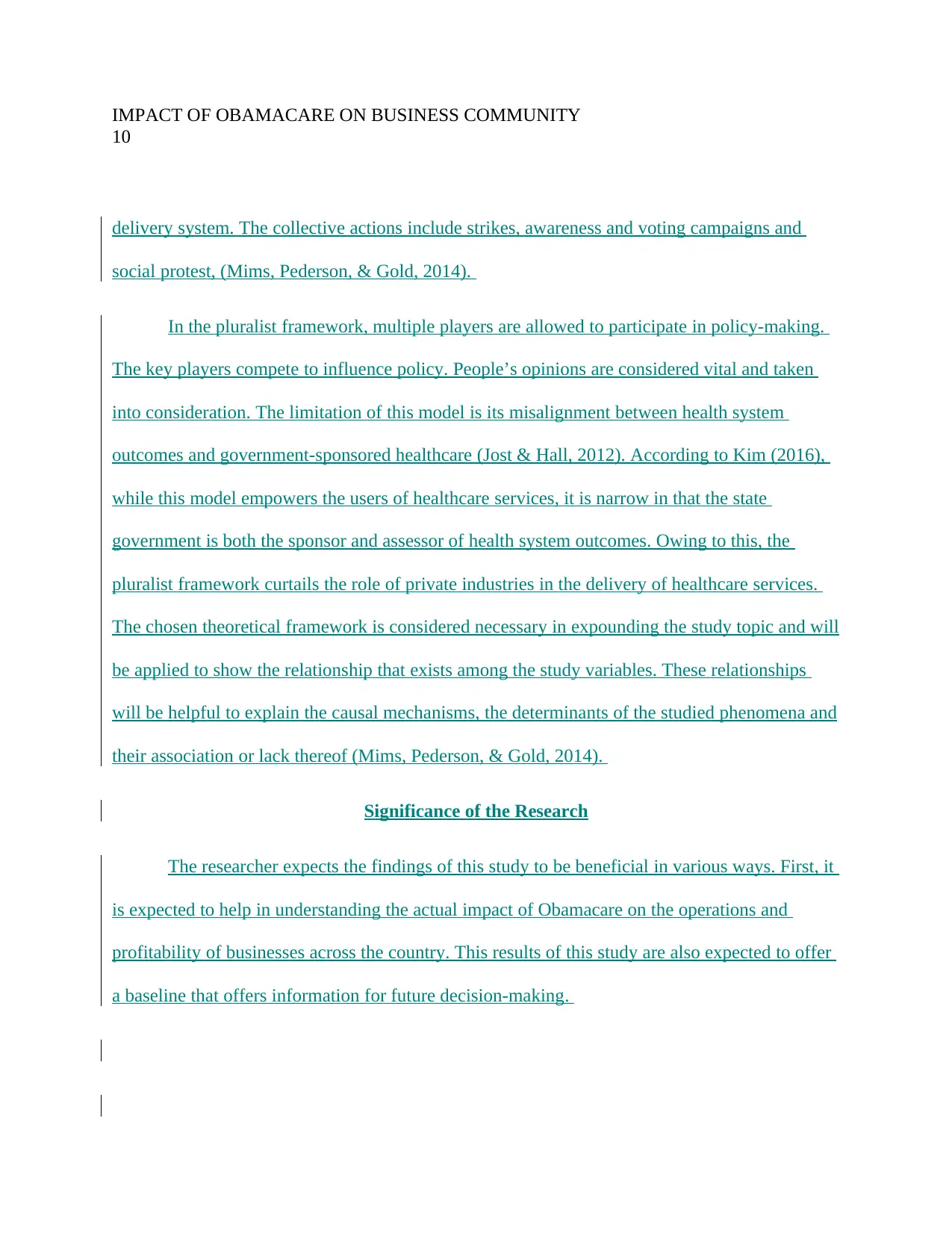
IMPACT OF OBAMACARE ON BUSINESS COMMUNITY
10
delivery system. The collective actions include strikes, awareness and voting campaigns and
social protest, (Mims, Pederson, & Gold, 2014).
In the pluralist framework, multiple players are allowed to participate in policy-making.
The key players compete to influence policy. People’s opinions are considered vital and taken
into consideration. The limitation of this model is its misalignment between health system
outcomes and government-sponsored healthcare (Jost & Hall, 2012). According to Kim (2016),
while this model empowers the users of healthcare services, it is narrow in that the state
government is both the sponsor and assessor of health system outcomes. Owing to this, the
pluralist framework curtails the role of private industries in the delivery of healthcare services.
The chosen theoretical framework is considered necessary in expounding the study topic and will
be applied to show the relationship that exists among the study variables. These relationships
will be helpful to explain the causal mechanisms, the determinants of the studied phenomena and
their association or lack thereof (Mims, Pederson, & Gold, 2014).
Significance of the Research
The researcher expects the findings of this study to be beneficial in various ways. First, it
is expected to help in understanding the actual impact of Obamacare on the operations and
profitability of businesses across the country. This results of this study are also expected to offer
a baseline that offers information for future decision-making.
10
delivery system. The collective actions include strikes, awareness and voting campaigns and
social protest, (Mims, Pederson, & Gold, 2014).
In the pluralist framework, multiple players are allowed to participate in policy-making.
The key players compete to influence policy. People’s opinions are considered vital and taken
into consideration. The limitation of this model is its misalignment between health system
outcomes and government-sponsored healthcare (Jost & Hall, 2012). According to Kim (2016),
while this model empowers the users of healthcare services, it is narrow in that the state
government is both the sponsor and assessor of health system outcomes. Owing to this, the
pluralist framework curtails the role of private industries in the delivery of healthcare services.
The chosen theoretical framework is considered necessary in expounding the study topic and will
be applied to show the relationship that exists among the study variables. These relationships
will be helpful to explain the causal mechanisms, the determinants of the studied phenomena and
their association or lack thereof (Mims, Pederson, & Gold, 2014).
Significance of the Research
The researcher expects the findings of this study to be beneficial in various ways. First, it
is expected to help in understanding the actual impact of Obamacare on the operations and
profitability of businesses across the country. This results of this study are also expected to offer
a baseline that offers information for future decision-making.
Paraphrase This Document
Need a fresh take? Get an instant paraphrase of this document with our AI Paraphraser
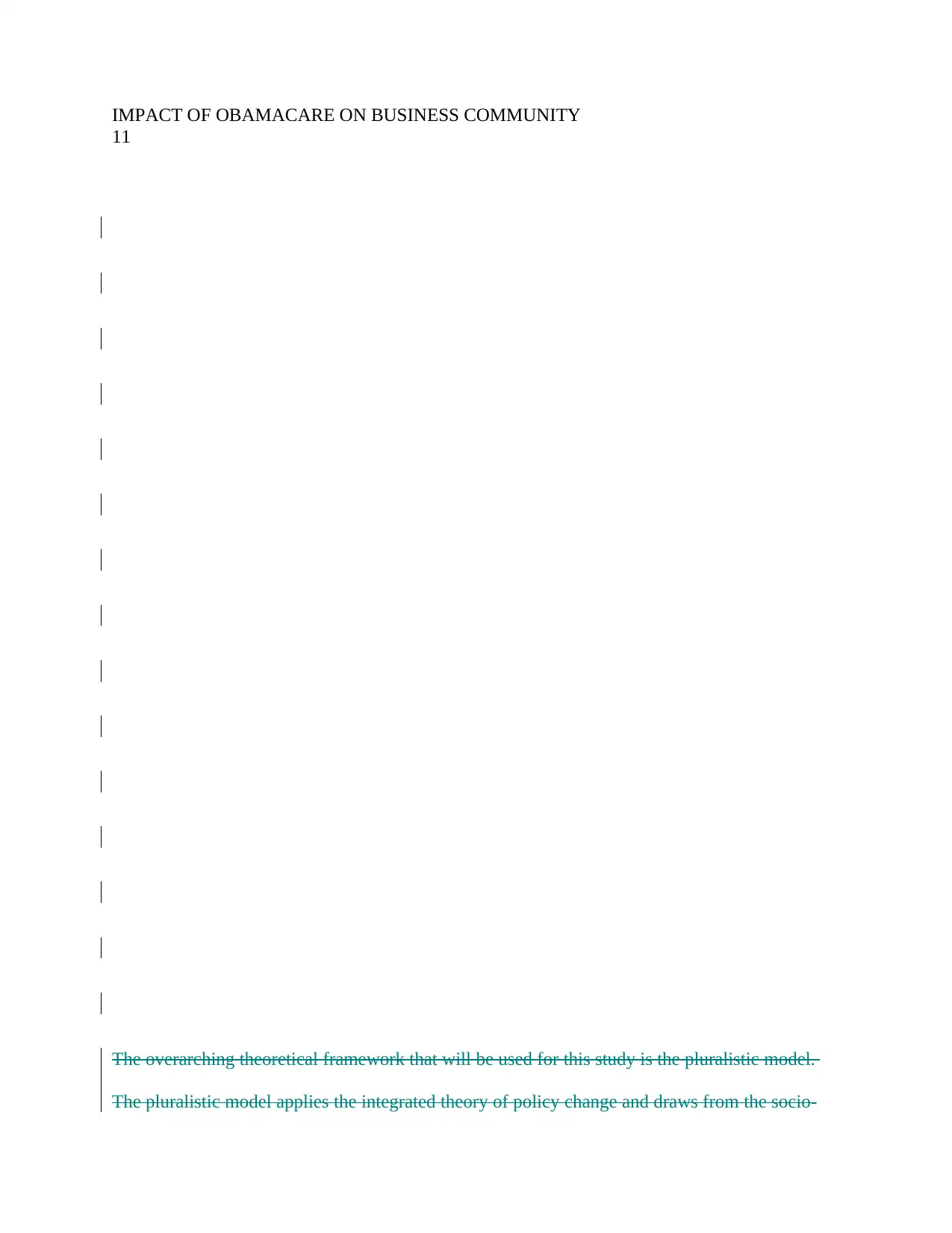
IMPACT OF OBAMACARE ON BUSINESS COMMUNITY
11
The overarching theoretical framework that will be used for this study is the pluralistic model.
The pluralistic model applies the integrated theory of policy change and draws from the socio-
11
The overarching theoretical framework that will be used for this study is the pluralistic model.
The pluralistic model applies the integrated theory of policy change and draws from the socio-
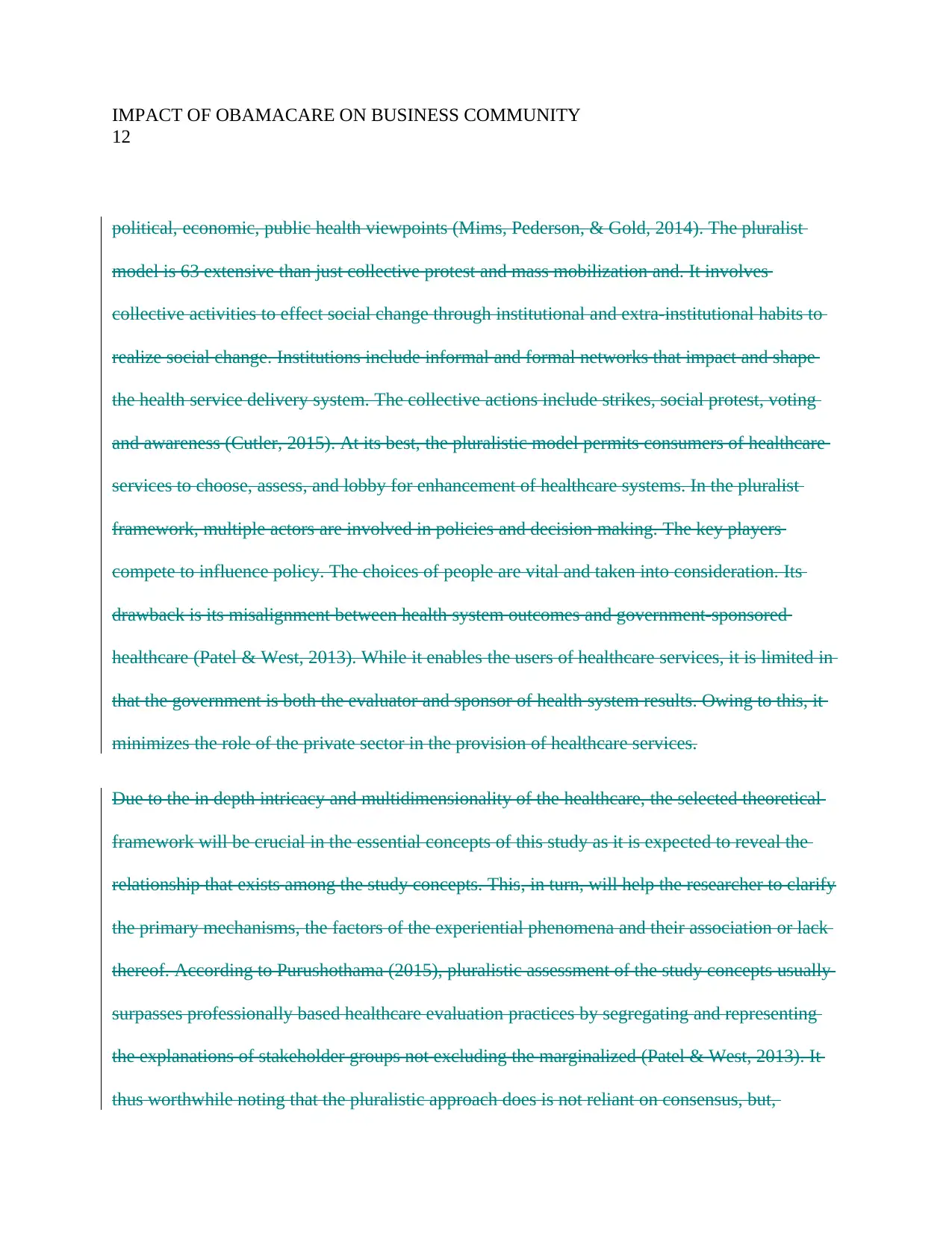
IMPACT OF OBAMACARE ON BUSINESS COMMUNITY
12
political, economic, public health viewpoints (Mims, Pederson, & Gold, 2014). The pluralist
model is 63 extensive than just collective protest and mass mobilization and. It involves
collective activities to effect social change through institutional and extra-institutional habits to
realize social change. Institutions include informal and formal networks that impact and shape
the health service delivery system. The collective actions include strikes, social protest, voting
and awareness (Cutler, 2015). At its best, the pluralistic model permits consumers of healthcare
services to choose, assess, and lobby for enhancement of healthcare systems. In the pluralist
framework, multiple actors are involved in policies and decision making. The key players
compete to influence policy. The choices of people are vital and taken into consideration. Its
drawback is its misalignment between health system outcomes and government-sponsored
healthcare (Patel & West, 2013). While it enables the users of healthcare services, it is limited in
that the government is both the evaluator and sponsor of health system results. Owing to this, it
minimizes the role of the private sector in the provision of healthcare services.
Due to the in depth intricacy and multidimensionality of the healthcare, the selected theoretical
framework will be crucial in the essential concepts of this study as it is expected to reveal the
relationship that exists among the study concepts. This, in turn, will help the researcher to clarify
the primary mechanisms, the factors of the experiential phenomena and their association or lack
thereof. According to Purushothama (2015), pluralistic assessment of the study concepts usually
surpasses professionally based healthcare evaluation practices by segregating and representing
the explanations of stakeholder groups not excluding the marginalized (Patel & West, 2013). It
thus worthwhile noting that the pluralistic approach does is not reliant on consensus, but,
12
political, economic, public health viewpoints (Mims, Pederson, & Gold, 2014). The pluralist
model is 63 extensive than just collective protest and mass mobilization and. It involves
collective activities to effect social change through institutional and extra-institutional habits to
realize social change. Institutions include informal and formal networks that impact and shape
the health service delivery system. The collective actions include strikes, social protest, voting
and awareness (Cutler, 2015). At its best, the pluralistic model permits consumers of healthcare
services to choose, assess, and lobby for enhancement of healthcare systems. In the pluralist
framework, multiple actors are involved in policies and decision making. The key players
compete to influence policy. The choices of people are vital and taken into consideration. Its
drawback is its misalignment between health system outcomes and government-sponsored
healthcare (Patel & West, 2013). While it enables the users of healthcare services, it is limited in
that the government is both the evaluator and sponsor of health system results. Owing to this, it
minimizes the role of the private sector in the provision of healthcare services.
Due to the in depth intricacy and multidimensionality of the healthcare, the selected theoretical
framework will be crucial in the essential concepts of this study as it is expected to reveal the
relationship that exists among the study concepts. This, in turn, will help the researcher to clarify
the primary mechanisms, the factors of the experiential phenomena and their association or lack
thereof. According to Purushothama (2015), pluralistic assessment of the study concepts usually
surpasses professionally based healthcare evaluation practices by segregating and representing
the explanations of stakeholder groups not excluding the marginalized (Patel & West, 2013). It
thus worthwhile noting that the pluralistic approach does is not reliant on consensus, but,
⊘ This is a preview!⊘
Do you want full access?
Subscribe today to unlock all pages.

Trusted by 1+ million students worldwide
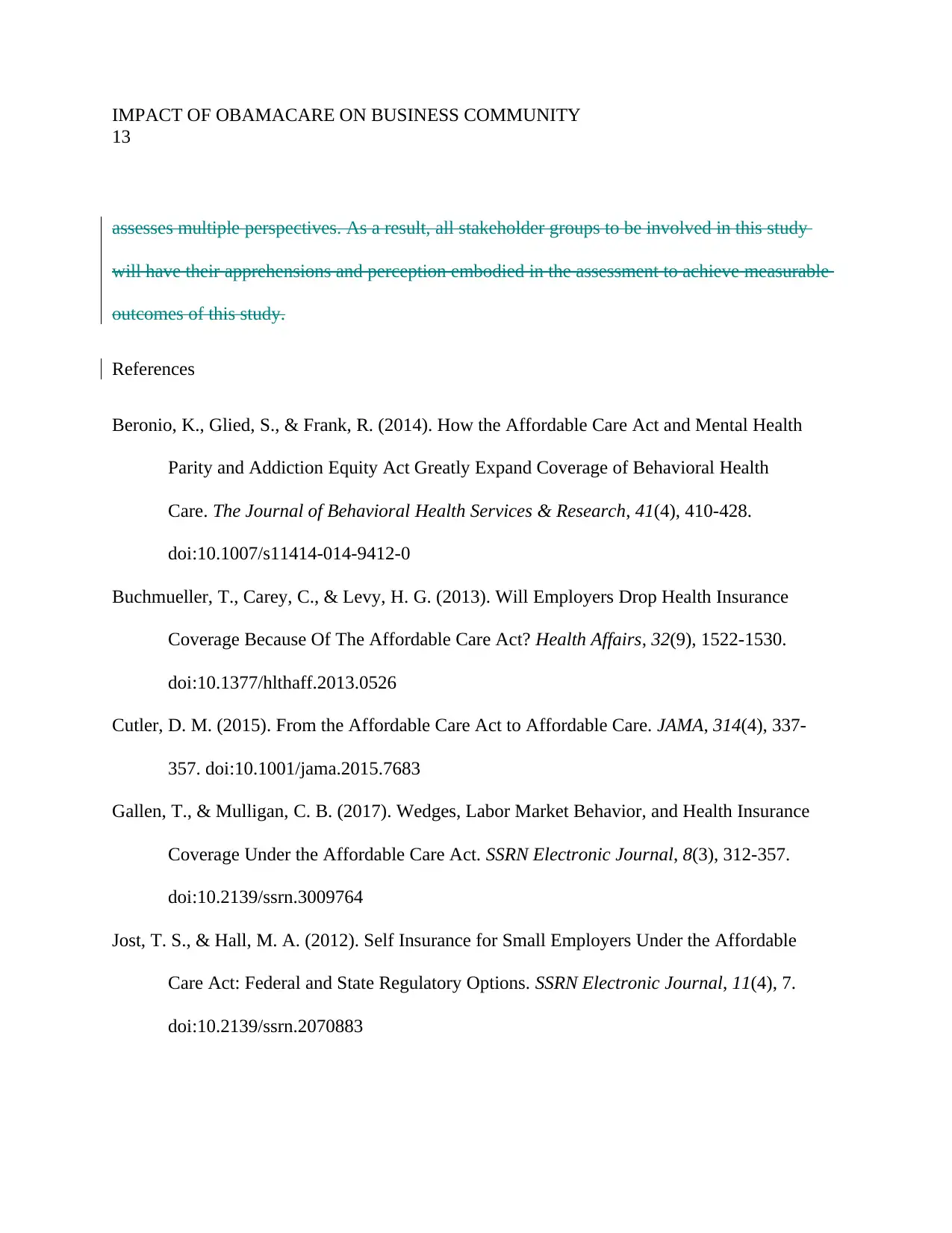
IMPACT OF OBAMACARE ON BUSINESS COMMUNITY
13
assesses multiple perspectives. As a result, all stakeholder groups to be involved in this study
will have their apprehensions and perception embodied in the assessment to achieve measurable
outcomes of this study.
References
Beronio, K., Glied, S., & Frank, R. (2014). How the Affordable Care Act and Mental Health
Parity and Addiction Equity Act Greatly Expand Coverage of Behavioral Health
Care. The Journal of Behavioral Health Services & Research, 41(4), 410-428.
doi:10.1007/s11414-014-9412-0
Buchmueller, T., Carey, C., & Levy, H. G. (2013). Will Employers Drop Health Insurance
Coverage Because Of The Affordable Care Act? Health Affairs, 32(9), 1522-1530.
doi:10.1377/hlthaff.2013.0526
Cutler, D. M. (2015). From the Affordable Care Act to Affordable Care. JAMA, 314(4), 337-
357. doi:10.1001/jama.2015.7683
Gallen, T., & Mulligan, C. B. (2017). Wedges, Labor Market Behavior, and Health Insurance
Coverage Under the Affordable Care Act. SSRN Electronic Journal, 8(3), 312-357.
doi:10.2139/ssrn.3009764
Jost, T. S., & Hall, M. A. (2012). Self Insurance for Small Employers Under the Affordable
Care Act: Federal and State Regulatory Options. SSRN Electronic Journal, 11(4), 7.
doi:10.2139/ssrn.2070883
13
assesses multiple perspectives. As a result, all stakeholder groups to be involved in this study
will have their apprehensions and perception embodied in the assessment to achieve measurable
outcomes of this study.
References
Beronio, K., Glied, S., & Frank, R. (2014). How the Affordable Care Act and Mental Health
Parity and Addiction Equity Act Greatly Expand Coverage of Behavioral Health
Care. The Journal of Behavioral Health Services & Research, 41(4), 410-428.
doi:10.1007/s11414-014-9412-0
Buchmueller, T., Carey, C., & Levy, H. G. (2013). Will Employers Drop Health Insurance
Coverage Because Of The Affordable Care Act? Health Affairs, 32(9), 1522-1530.
doi:10.1377/hlthaff.2013.0526
Cutler, D. M. (2015). From the Affordable Care Act to Affordable Care. JAMA, 314(4), 337-
357. doi:10.1001/jama.2015.7683
Gallen, T., & Mulligan, C. B. (2017). Wedges, Labor Market Behavior, and Health Insurance
Coverage Under the Affordable Care Act. SSRN Electronic Journal, 8(3), 312-357.
doi:10.2139/ssrn.3009764
Jost, T. S., & Hall, M. A. (2012). Self Insurance for Small Employers Under the Affordable
Care Act: Federal and State Regulatory Options. SSRN Electronic Journal, 11(4), 7.
doi:10.2139/ssrn.2070883
Paraphrase This Document
Need a fresh take? Get an instant paraphrase of this document with our AI Paraphraser
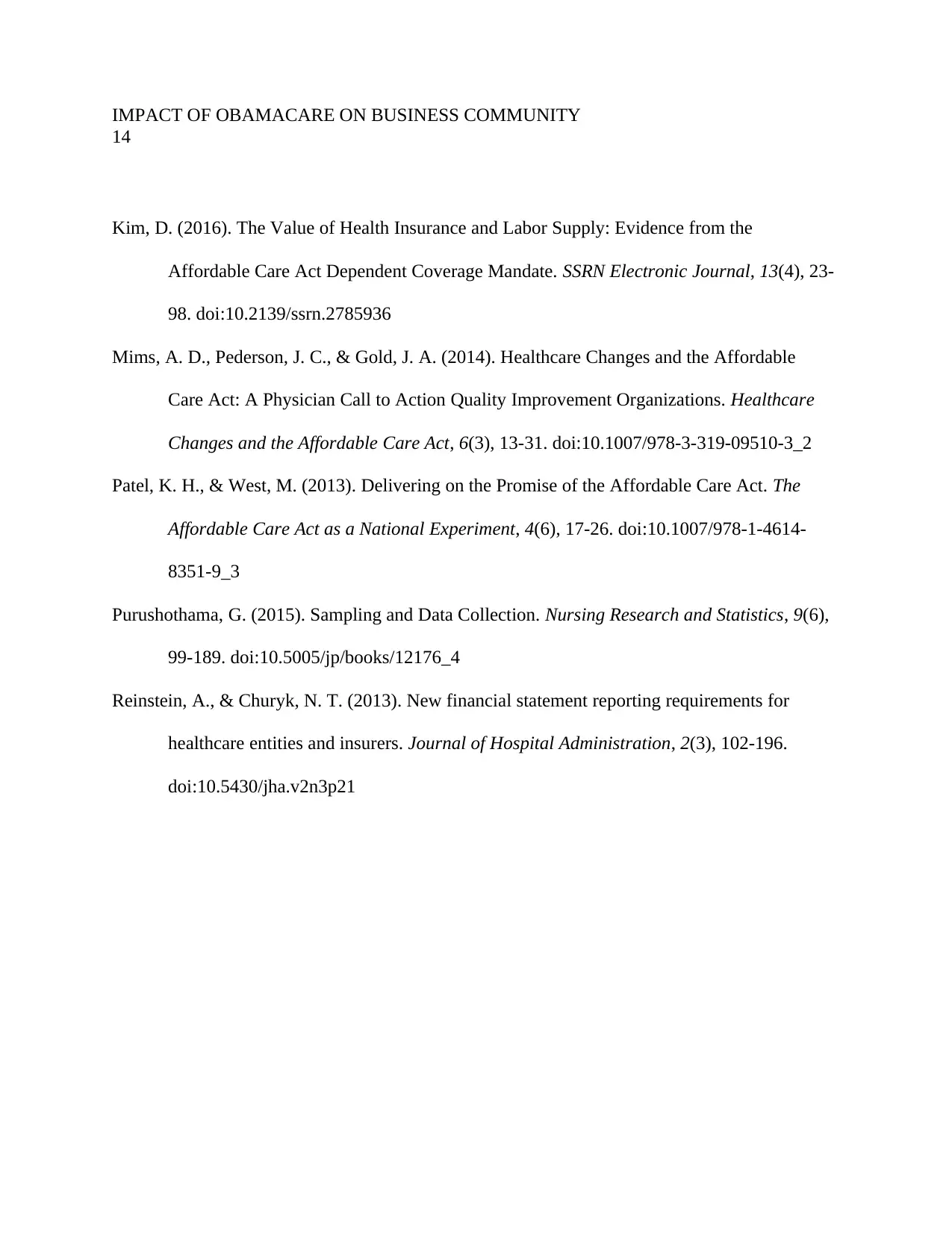
IMPACT OF OBAMACARE ON BUSINESS COMMUNITY
14
Kim, D. (2016). The Value of Health Insurance and Labor Supply: Evidence from the
Affordable Care Act Dependent Coverage Mandate. SSRN Electronic Journal, 13(4), 23-
98. doi:10.2139/ssrn.2785936
Mims, A. D., Pederson, J. C., & Gold, J. A. (2014). Healthcare Changes and the Affordable
Care Act: A Physician Call to Action Quality Improvement Organizations. Healthcare
Changes and the Affordable Care Act, 6(3), 13-31. doi:10.1007/978-3-319-09510-3_2
Patel, K. H., & West, M. (2013). Delivering on the Promise of the Affordable Care Act. The
Affordable Care Act as a National Experiment, 4(6), 17-26. doi:10.1007/978-1-4614-
8351-9_3
Purushothama, G. (2015). Sampling and Data Collection. Nursing Research and Statistics, 9(6),
99-189. doi:10.5005/jp/books/12176_4
Reinstein, A., & Churyk, N. T. (2013). New financial statement reporting requirements for
healthcare entities and insurers. Journal of Hospital Administration, 2(3), 102-196.
doi:10.5430/jha.v2n3p21
14
Kim, D. (2016). The Value of Health Insurance and Labor Supply: Evidence from the
Affordable Care Act Dependent Coverage Mandate. SSRN Electronic Journal, 13(4), 23-
98. doi:10.2139/ssrn.2785936
Mims, A. D., Pederson, J. C., & Gold, J. A. (2014). Healthcare Changes and the Affordable
Care Act: A Physician Call to Action Quality Improvement Organizations. Healthcare
Changes and the Affordable Care Act, 6(3), 13-31. doi:10.1007/978-3-319-09510-3_2
Patel, K. H., & West, M. (2013). Delivering on the Promise of the Affordable Care Act. The
Affordable Care Act as a National Experiment, 4(6), 17-26. doi:10.1007/978-1-4614-
8351-9_3
Purushothama, G. (2015). Sampling and Data Collection. Nursing Research and Statistics, 9(6),
99-189. doi:10.5005/jp/books/12176_4
Reinstein, A., & Churyk, N. T. (2013). New financial statement reporting requirements for
healthcare entities and insurers. Journal of Hospital Administration, 2(3), 102-196.
doi:10.5430/jha.v2n3p21
1 out of 14
Related Documents
Your All-in-One AI-Powered Toolkit for Academic Success.
+13062052269
info@desklib.com
Available 24*7 on WhatsApp / Email
![[object Object]](/_next/static/media/star-bottom.7253800d.svg)
Unlock your academic potential
© 2024 | Zucol Services PVT LTD | All rights reserved.




